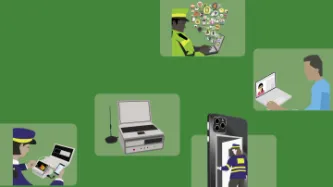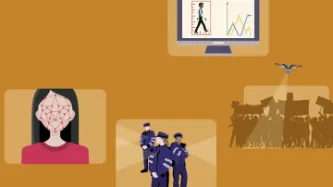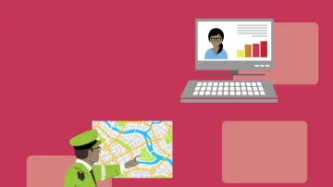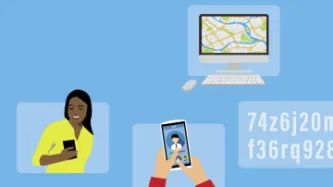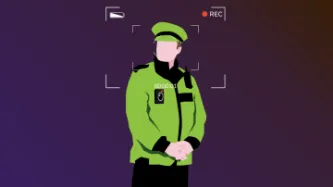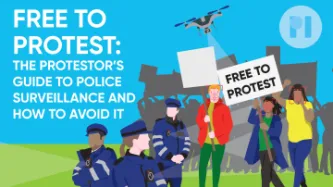Advanced Search
Content Type: Long Read
Across the world facial recognition technologies (FRT) are increasingly being deployed in public and private spaces without adequate laws or regulation to protect individuals from the grave risks they pose to human rights. States rely more and more on this technology for public mass surveillance, enabling an authoritarian omnipresence over people’s activities, movements, and expressions at all times, often without them knowing.Over the past few years we have raised concerns about the rapid…
Content Type: Examples
The energy company Cuadrilla used Facebook to surveil anti-fracking protesters in Blackpool and forwarded the gathered intelligence to Lancashire Police, which arrested more than 450 protesters at Cuadrilla's Preston New Road site over a period of three years in a policing operation that cost more than £12 million. Legal experts have called the relationship between fracking companies and the police "increasingly unhealthy" and called on the ICO and the Independent Office for Police Conduct to…
Content Type: Examples
Environmental campaigners wrote to Scottish first minister Nicola Sturgeon asking her to intervene to ensure the right to protest was upheld during COP26, when as many as 10,000 police officers from all over the UK were deployed per day on the streets of Glasgow. The letter said the police were reportedly filming campaigners, eavesdropping on conversations, unlawfully demanding personal details, and in one case followed a group to where they were staying even though no protest was in progress.…
Content Type: Examples
The 20 years since the 9/11 attacks have fundamentally changed the way the New York Police Department operates, leading it to use facial recognition software, licence plate readers, and mobile X-ray vans, among other surveillance tools for both detecting and blocking potential terrorist attacks and solving minor crimes. Surveillance drones monitor mass protests, antiterrorism officers interrogate protesters, and the NYPD’s Intelligence Division uses antiterror tactics against gang violence and…
Content Type: Examples
The Myanmar military are stopping people in the street, checking through the data on their phones, and taking them to jail if they find suspicious messages or photos. At least 5,100 people were still in jail many months after opposing the February 1, 2021 military takeover. The spontaneous searches also deter individuals from continuing to post on social media or lead them to create new accounts they hope will evade detection, and avoid crowded streets where police or soldiers are likely to be…
Content Type: Examples
July 2021 saw violent protests that left 72 people dead and 1,300 in prison after former president Jacob Zuma was jailed for failing to appear before a constitutional court’s inquiry into corruption during his time in office. In response, the South African government deployed the military onto the streets in the provinces of Gauteng and Kwazulu Natal, and began monitoring social media platforms and tracking those who “are sharing false information and calling for civil disobedience”. President…
Content Type: Examples
The South African government urged social media platforms to trace and remove posts that incite violence, share false information, and call for civil disobedience after a July 2021 series of spiralling protests sparked by the jailing of former president Jacob Zuka. A number of other African countries such as eSwatini, Senegal, Nigeria, Uganda, Niger, and the DRC have also been increasingly using tracking software, internet shutdowns, and social media monitoring during protests and elections.…
Content Type: Examples
Following the largest protests seen on the island in decades, Cuba’s government introduced new social media regulations that make inciting acts that alter public order a crime, and ordered ISPs to shut off access for those who “spread fake news or hurt the image of the state”. Critics believe the new rules are intended to curb dissent, as the protests spread across the island from a small town, where the first protest was convened in an online forum and spread via a Facebook livestream. Deputy…
Content Type: Examples
The global internet monitoring firm NetBlocks finds that Cuba has restricted access to social media and messaging platforms including Facebook, Instagram, and WhatsApp, as well as some Telegram servers, on the govt-owned telecom provider ETECSA during the largest protests the country has seen in decades. Access to the streaming services YouTube and Google Video was also limited. The protests focused on rising prices, curbs on civil liberties, and the government’s handling of the pandemic.…
Content Type: Examples
Israel is abandoning its longstanding tactic of raiding Palestinian homes for “intelligence mapping” in favour of digitised surveillance that includes a vast and sophisticated 20-year-old network of CCTV, ANPR, and IP cameras throughout the Old City in East Jerusalem (“Mabat 2000”), automated facial recognition-equipped checkpoints (provided by the domestic company AnyVision) between Israel and the occupied West Bank, and drone surveillance at Palestinian protests. The drones over weekly…
Content Type: Long Read
This is based on UK data protection legislation. The UK’s General Data Protection Regulation (UK GDPR) does not apply to processing of personal data for law enforcement purposes by relevant authorities.
What can happen to my personal data at a peaceful protest?
The most common personal data processed at a protest are notes and photographs taken by police officers, along with voice and video recordings taken from body-worn cameras or drones.
Data processing can also happen with…
Content Type: Long Read
Photographing or filming incidents involving police and protestors is an important way of holding the police to account for their actions. Members of the public and the media do not need a permit to film or photograph in public places and police have no power to stop them filming or photographing incidents or police personnel.[1]
Can the police stop and search me for filming or taking photographs?
The police have the discretion to ask you to move back if they think you are interfering with…
Content Type: News & Analysis
Imagine going to a peaceful protest and having to show your ID to the police before you can join it. Or having to fill out a form about why you are attending that particular protest.Sounds absurd, right? Surely we should all be free to protest, without the police knowing who we are?But high tech surveillance of protests is real, and it enables the police to identify, monitor and track protestors, indiscriminately and at scale.For example, your face is increasingly becoming your ID card with the…
Content Type: Explainer
‘Free to Protest: The protestor’s guide to police surveillance and how to avoid it’ (UK edition) is a collection of bite-sized guides about high-tech police surveillance capabilities at protests, including tips and strategies about how you can protect yourself from being identified, tracked and monitored. Each guide is self-contained so you don’t need to read the whole thing, or read it any particular order. You can access each separate section of the guide from the campaign homepage, but if…
Content Type: Examples
While traditional media sought to criminalize the widespread November 2020 protests in Peru following the Congressional ouster of President Vizcarra, witnesses disseminated videos and photographs of police abuse on social networks. In the fear and uncertainty, many myths also circulated. In Peru, citizens have the right to refuse to allow police to check their cellphones unless they have a court order; slowed or absent wireless connections may simply be due to overload; as public officials,…
Content Type: Examples
In December 2020 Myanmar authorities began rolling out its $1.2 million "Safe City" system of 335 Huawei AI-equipped surveillance cameras in eight townships in the capital, Naypyidaw. The system, whose purpose was originally presented by the Myanmar government as fighting crime, automatically scans faces and vehicle licence plates in public places and alerts authorities to the presence of those on a wanted list. The Safe City plan calls for installing similar systems in Mandalay by mid-2021 and…
Content Type: Examples
Hundreds of pages of Myanmar government budgets for the last two fiscal years obtained by the New York Times show that the Myanmar military who staged a coup in February 2021 had new and sophisticated tools at their disposal: Israeli-made, military-grade surveillance drones, European iPhone cracking devices, and US software that can hack into computers and extract their contents. Purchases of sensitive dual-use cybersecurity and defence technology continued during the five years in which the…
Content Type: Examples
The internet, mobile, and social media shutdown in Myanmar left protesters vulnerable to rumours and at a disadvantage in organising opposition to the 2021 military coup. Coordination was done via phone, word of mouth, and the Bluetooth-based messaging app Bridgefy, which was downloaded more than 1 million times in Myanmar in the days after the coup. All plans include both online and offline contingency arrangements; a second disruptive possibility is intermittent interruptions and throttling…
Content Type: Examples
The Belarusian government is using the "Kipod" facial recognition software developed by the local software company LLCC Synesis to track and identify dissidents. Synesis was previously sanctioned by the EU for providing authorities with an AI surveillance platform capable of tracking individuals. Kipod uses biometrics machine learning algorithms to analyse material. Synesis has denied that the technology could be used to identify protesters, but the Belarusian government decreed the…
Content Type: Examples
In August 2020, controversial Belarusian president Alexander Lukashenko cut off most of the nation's access to the internet in hopes of disrupting the protests against the vote-rigging that saw him installed as president. Online news sites were left largely offline from election day onward, and demonstrators had to scramble to find wifi connections and working VPNs or proxies in order to share whatever news they could find. Protests therefore relied on popular bloggers on Telegram channels to…
Content Type: Examples
Despite its indications of support for the pro-democracy protesters, in October 2020 the EU bought the Belarusian authorities 15 surveillance drones, raising concerns that the video equipment they carry would be used to identify and arrest individual pro-democracy protesters. The EU foreign service paid for them out of an €850,000 neighbourhood project handled by Latvia and Lithuania, and denied that they could be used to identify individuals. The drones were intended for use to patrol EU…
Content Type: Examples
The 2020 Belarus protests were the largest in the country's history and brought an unprecedented crackdown, in which protesters nationwide were tortured and criminally prosecuted as a means of repressing peaceful assembly. A report finds that these cases became political as the government violated the presumption of innocence and meted out disproportionately harsh sentences. The report found no reports of disciplinary action taken against law enforcement officers who exceeded their authority by…
Content Type: Examples
In 2019, interviews with Hong Kong protesters destroying smart lampposts revealed that many distrusted the government's claim that they would only take air quality measurements and help with traffic control, largely because of the comprehensive surveillance net the Chinese government was using to control and oppress the minority Uighur population in the Xinjiang region. As part of their response to this threat, the protesters wore masks, carried umbrellas, and travelled on foot, using online…
Content Type: Examples
In 2019 Hong Kong protesters cut down 20 of the city's smart lampposts, which are streetlights equipped with sensors and cameras, in order to counter the threat that they were vectors for surveillance technologies such as facial and licence plate recognition. TickTack Technology, which provided the lampposts, terminated its contract with the Hong Kong government because of the property damage and threats to its employees. Protesters uploaded pictures of the lampposts' inner workings to Facebook…
Content Type: Examples
During 2019, Hong Kong law enforcement authorities had access to AI facial recognition software provided by Sydney-based iOmniscient that can match faces and licence plates from video footage to police databases, but chief executive Carrie Lam's administration and police did not confirm whether they were using it to quash the pro-democracy protests. IOmniscient is also used to find lost children and manage traffic and has users in more than 50 countries. Under Hong Kong's privacy laws, members…
Content Type: Examples
As police began treating every 2019 Hong Kong protest as an illegal assembly attracting sentences of up to ten years in jail, facial recognition offered increased risk of being on the streets, as protesters could be identified and arrested later even if they were in too large a crowd to be picked up at the time. By October, more than 2,000 people had been arrested, and countless others had been targeted with violence, doxxing, and online harassment. On the street, protesters began using…

